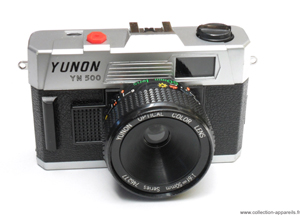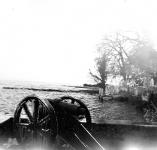|
Yunon Optical Deluxe-I |
Manufactured or assembled in Taiwan from (Circa) 1980 to (After) 1980.
Index of rarity in France: Frequent (among non-specialized garage sales)
Inventory number: 2675
See the complete technical specifications
Chronology of cameras Yunon Optical
Yunon Optical Company Limited was established in Pei Tou, a suburb of Taipei, in 1974. The Yunon brand for cameras and photographic equipment was registered in the United States in 1984.
In 1984, there were at least four major players in the American market for very inexpensive 35mm cameras. These were Formosa Plastics Corporation (FPC), Yunon Optical Company, New Taiwan Photographic Corporation (Ouyama 1982), and A.V. Lavec (1978), which was initially a brand associated with the manufacture of kitchenware and utensils. While the cameras were all different, many of them shared the same lenses. This could suggest that either the lenses and shutters were made by a single company, or that components were made by one company and assembled by others, or that the cameras were manufactured on demand by one company and distributed by others.
The cameras are made of plastic. They sometimes roughly resemble SLRs, but the bulge of the hood houses no prism. The lack of credibility in lightweight is often compensated by the addition of lead weights in the lower part of the cameras. Film movement is manual.
The same model can be found under countless "brands," making it difficult to distinguish between brands and manufacturers.
Some people describe these cameras as toys, but they have superior specifications to many Instamatic cameras of the '70's and '80's !
At Yunon Optical, we can identify several types of cameras:
| markings on lens | # on lens | |||
 Metal fabrication |
Penmax YN-3 |  |
New Penmax Color Optical Glass Lens F-45mm | |
 Rangefinder design |
Yunon YN 500 |  |
Yunon Optical Color Lens 1:6 f=50mm Series 746277 |
746277 |
Rangefinder design |
Yunon Super II | Yunon Optical Glass Lens 1:6 f=50mm Series 746277 |
746277 | |
 |
YN-990 | Optical Color Lens Auto Fix Focus 50mm Lens 1:6 |
||
 |
Royal-I | Optical Lens 50mm 1:6.3 |
||
 SLR Design. Viewfinder aligned with the lens |
Yunon Deluxe-I | Optical Color Lens Auto Fix Focus 50mm Lens 1:6 Made in Japan |
||
| Kinusa Deluxe-I | ||||
| Yunon Deluxe-I |  |
|||
| Quartz Deluxe-I | ||||
| Asaflex 35 T | ||||
The Yunon brand disappeared in the United States in 2005, and the premises of Yunon Optical Company Ltd in Taipei are now occupied by the Shangri-La Far Eastern Hotel. __________
This camera was manufactured by Yunon Optical Company in Pei Tou Chu, Taipei.
Yunon expanded its range by putting different names on identical cameras, much like the Great Wall Plastics Company did with the Diana series in the 1960s.
Yunon cameras all feature an untreated meniscus lens (typically made of plastic) advertised with a focal length of 50mm, with a maximum aperture of 5.6, 6.0, or 6.3, described as an Optical Color Lens. They all have four apertures, sometimes listed as F6, F8, F11, and F16.
This one has two sets of weather symbols for 100 and 200 ISO.
This camera has a curved film plane which likely helps correct the distortion from the meniscus lens.

Interesting links or bibliography :
Add a link or element of bibliography, a picture taken with this camera, a picture of box or an ads about this camera
Your photos taken with the same camera:
Cameras from Ebay France (Yunon Optical) (Uploaded each 3 hours)







